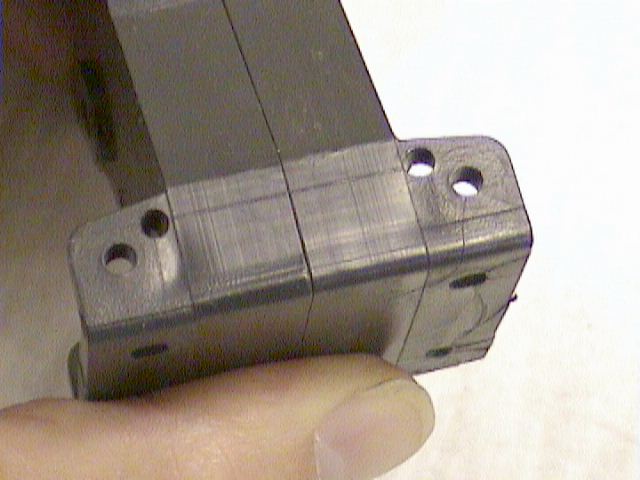This is a shame, as it is a most important aspect of bringing the performance of the Cobra on par with that of the oposition. It was the part that I did first; all the other mods are really designed to overcome the added grip and stability at the back. It provides the grip to leap out of slow corners. In my case this usually results in ramming the car in front but you may be better at it.
If you have your car sat on the ground, as though it were just about to leap off the line, and then prevent the rear wheels from turning as you gently apply some power; I am pretty sure that the rear of the car would attempt to move downwards. This is squatting. The trouble is that if you look at from the car's perspective, the damn thing is trying to lift its wheels off the ground. I am sure that you can appreciate that when you are trying to transmit the maximum amount of drive, you need the maximum amount of grip, and the last thing you want to do is reduce the force with which the car is pushing its tyres into the turf.
If you think about it, the only components of your average 2wd buggy rear suspension that can exert a sustained forward force on the rest of the car are the wishbones. What is more, the line of action of these forces can only be along their pivots. So what we do is incline the pivot such that it is higher at the front than the back. This has the effect of exerting an upward force on the chassis which must ultimately be opposed by a downward force onto the track. Hence the car tries to force its wheels into the turf for more grip. I have gone for 3º of anti-squat and toe-in.
The effects of toe-in are beyond my comprehension. Suffice it to say that it makes the rear of the car more stable. It will work aginst the tendency for the car to "write its name" as it goes down the straight but will also work against its ability to turn-in without your coming off the power.
So how do you do it?
It is a bit of a fiddle. I had hoped that I would have been able to manufacture a replacement gearbox by now but since the level of interest has been low I have not deemed it necessary.
To be brief, you have to completely fill the existing holes that take the 3mm diameter pivot pin at the front of the gearbox and re-drill some new ones. I used Araldite Rapid to fill the existing holes but any similar product would do the trick. Seal the back of the hole with tape and feed the goo in from the front. Do try to make sure that you completely fill the existing hole as it makes life a bit easier when it comes to drilling the new holes as these will be half in one material and half in another. If you are going to stand any chance of a matched pair (Left and Right) then the last thing you want is an air bubble to throw the drill off. Having just realised that I can't give you the exact dimension to achieve the 3 degree incline until I go out in the cold to measure the darn thing you will have to wait a bit. Sorry
When it comes to drilling the holes you will need to start of withe the smallest drill that you have, say 1mm, and then gradually increase the size of hole until you achieve the desired diameter and direction. I think that I may have put the drills above 2mm in diameter in a tap wrench and gradually eased them over until they would enter the hole in the rear bracket.
I have been receiving some e-mails on this subject from one James Fish. I include here the substance of our conversation.
| Hi
James, Sorry for the delay. You have set me off measuring things and I've discovered that my original assumption with regard to the anti-squat and toe-in were wrong. The standard Cobra has about 3.8 degrees of anti-squat and 1.6 degrees of toe-in. So what I have done is increase these by 3 degees each to 6.8 and 4.6 respectively. The anti-squat might be a bit over the top but I like it. You may like to try a little less. To give the three degree movement you will need to move the front holes up by 1mm and in by 1mm. On the gearbox I have in front of me that should be 9mm from the bottom of the gearbox and 17.8 from the split line. Actually I only have a RH gearbox half in front of me so you had better check that the split line is on the middle. Regards Clive |
| This was one of my earlier attempts but it shows roughly what we are trying to do. Obviously I have given it too much of everything on this one. The original holes must be filled with epoxy resin as the new ones will overlap. |  |
